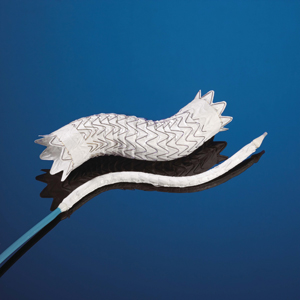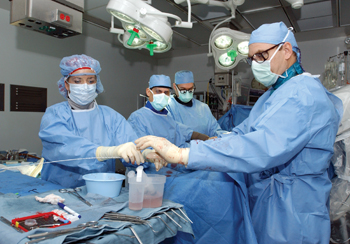
The TAG graft is threaded into the aorta compressed around a guide wire, and with the pull of a rip cord expands to fill the inside of the artery's wall, bypassing a swelling, threatening aneurysm.
New aneurysm graft leaves chests closed

Instead of opening a patient's chest, Tom Naslund, M.D., right, and scrub nurse Beth Spallinger, R.N., thread the new graft into the thoracic aorta on a thin wire through a small incision in the groin. Jim Bob Faulk, M.D., and Raul Guzman, M.D., assist.
photo by Anne Rayner
Tommy Johnson had three options, and he didn't like two of them.
Johnson, 72, had just experienced a second aortic aneurysm, the ballooning in the wall of an artery. The first, in his abdomen, was repaired two years ago. This one swelled in his thoracic aorta, just beneath the vessel's bend after it leaves the heart. On a CT image it looked like a flooded pool stretched beyond a river's bank.
He could ignore the aneurysm, but if it failed it would surely result in a quick death. He could have it fixed, but when he had the abdominal aneurysm fixed, at a hospital near his hometown of Mayfield, Ky., he spent more than three weeks in the hospital, a scenario he didn't want to repeat.
So his physician sent him to Vanderbilt, where Tom Naslund, M.D., chief of Vascular Surgery, was trying a new procedure. "I didn't really have a choice," Johnson said on May 3, the day before his surgery here. "It could pop anytime. This is the only chance I have to live longer."
Naslund had tested the W.L. Gore TAG, an aortic graft, while it was still undergoing FDA review. Johnson was the first patient to receive the graft in Middle Tennessee, according to a Gore spokesman, after it was approved in April.
Thoracic aneurysms typically occur in older patients, many of whom have other health problems, and the "open" approach — cracking the chest to access the aorta — is the traditional technique. "The surgical risk is often greater than the aneurysm risk," Naslund says. "Patients spend a lot of time in their golden years recovering from surgery instead of living."
The TAG graft is made of the same waterproof, tear-resistant material found in sports jackets and other high-end apparel, reinforced for rigidity.
In Johnson's case, Naslund threaded the graft on a wire inserted in the groin and navigated the device up the femoral artery to the aorta. Angiogram images mapped the wire's position during the procedure. Naslund fitted one graft into place, pulled a 'ripcord' and the tubular device sprung open and embraced the aortic wall. He sent another one up, fitted it into the bottom of the first one, and deployed it, and an angiogram soon showed the aorta appearing as one consistent channel again.
Nationwide, 10,000 to 15,000 people have thoracic aortic aneurysms repaired. Naslund says he suspects he's done his last open procedure, with a few exceptions.
The graft isn't perfect — there's still a chance the aneurysm will bleed through the graft, so patients will be watched closely. But the benefits are obvious: a small incision in the groin instead of being cut open in a major operation. In the trial, the data showed an 80 percent reduction in blood loss, a reduction in risk of paraplegia from 14 percent to 3 percent, a reduction in mortality from 6 percent to 1 percent and far fewer days in the hospital, from 10 to three (from three days to one in the ICU).
Johnson's procedure wrapped up at 9:30 a.m.; the next morning he was ready to go home. "It went so well I was amazed," said his wife, Wanda.
Tommy was ready to hit the road — back home and back to work. He drives a semi truck from Mayfield to El Paso, Texas and back on a four-day haul. But he's probably most excited about having peace of mind.
"I don't have to go to bed at night not knowing if it was going to burst. That's a weird feeling. Now I can go to bed and not worry."













